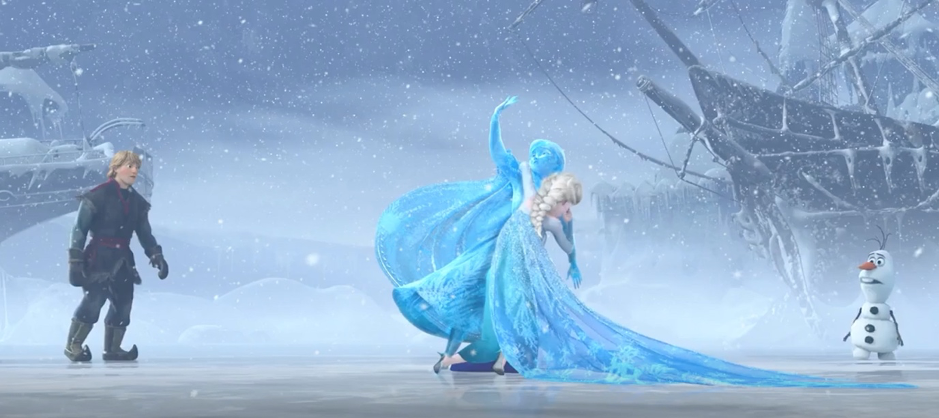It is well-known that a major source of inspiration for Chris Buck and Jennifer Lee’s Frozen (2013) was Hans Christian Andersen’s fairy tale The Snow Queen (1844). Buck and Lee follow the Danish writer’s story by building the feature’s plot on a search for the Snow Queen. Elsa, loosely based on Andersen’s character, freezes the Scandinavian Kingdom of Arendelle and conceals herself in an icy tower, after which her younger sister Anna sets off on a mission to bring her back. Although building the feature’s plot on Andersen’s Snow Queen, Buck and Lee play with the power of (un)freezing and disperse it among its many characters in a different way from Andersen. As a result, they deviate from Andersen’s original tale and create a universe in which the figure of the Snow Queen turns from a cold ‘Andersenian’ antagonist into a multi-layered, sisterly character.
Inspired by the dynamics of freezing and unfreezing in Andersen’s Snow Queen and Buck and Lee’s Frozen, this article poses a simple question: who does the freezing and who does the unfreezing? In answering this question, I take the ability to freeze and unfreeze as a guiding element in looking at how Andersen’s characters from The Snow Queen evolve in Buck and Lee’s Frozen. In observing the characters’ development through an evolution of their power to freeze and unfreeze, I simultaneously refer to Snezhnaya koroleva (The Snow Queen), Lev Atamanov’s 1957 filmic adaptation of Andersen’s tale, The Snow Queen. Atamanov’s early adaptation follows The Snow Queen’s storyline with little changes to the original plot and characters. This way, Atamanov’s adaptation allows us to visually track and demonstrate how Andersen’s characters and their power to (un)freeze evolve in the world of Frozen.
Let us start with Andersen’s Snow Queen. In Andersen’s storyworld, the ability to freeze and unfreeze is dispersed among the story’s three main characters: the Snow Queen, and the two children Gerda and Kay. Andersen’s Snow Queen is the story’s antagonist and possesses the power to freeze. She freezes Kay’s heart, takes him into the depths of Lapland, and keeps him in her icy castle. Gerda, the story’s protagonist, possesses the power to unfreeze. Determined to return Kay to their village, she leaves her home and travels to Lapland. After finding Kay “quite blue with cold – indeed, almost black” (Andersen, 2013/1986: 338) in the Snow Queen’s castle, Gerda unfreezes his heart with tears, which Atamanov depicts in a touching scene at the end of the movie (see Figure 1).

Atamanov’s scene – from the characters’ similar posture to the scene’s icy background – echoes the moment when Elsa unfreezes Anna with the power of true love in Frozen (see Figure 2).

While the two scenes are similar in the characters’ posture and the scene’s background, they simultaneously illustrate the difference in the way the power to (un)freeze is dispersed among the characters in Frozen. Unlike Andersen’s Snow Queen, Elsa possesses both the power to freeze and unfreeze: she accidentally freezes Arendelle and Anna but also unfreezes them at the end of the movie. At the same time, we can also draw a parallel between Elsa and Kay, as both characters kickstart the plot by vanishing into the depths of Scandinavia and motivating Anna’s and Gerda’s search respectively. Therefore, from this perspective, Andersen’s three protagonists somehow merge in the figure of Elsa.
A similar evolution is visible in Buck and Lee’s Anna. Just like Andersen’s protagonists merge in Elsa’s figure, Kay and Gerda’s character traits are embedded in Anna’s. She resembles Kay in being the character who eventually becomes frozen and shares Gerda’s determination to find Elsa. Even though Anna physically neither does the freezing nor the unfreezing (unlike Gerda), she is metaphorically the key to unfreezing Arendelle, as she allows Elsa to take control of her magic once she realizes that love melts ice.
So, what does the different distribution of the power to (un)freeze among Andersen’s and Buck and Lee’s characters tell us about their evolution? Essentially, concentrating the power to freeze and unfreeze in Elsa, rather than dispersing it among, say, Elsa, Anna, and Kristoff, allows Buck and Lee to create a more complex Snow Queen. By turning Elsa into the only character who does the freezing and unfreezing, Andersen’s Snow Queen evolves from a one-dimensional antagonist into a character who struggles to control her powers and who, by learning how to control them, develops and strengthens throughout the movie. In other words, while Andersen (and, in turn, Atamanov) portrays the Snow Queen as cold and one-dimensional (i.e., without any development throughout the story), Buck and Lee turn Elsa into a strong figure whose character development is fueled by her possession of two contrasting powers. Once Elsa realizes that the key to unfreezing Anna is love, this realization instantly allows her to ‘unfreeze’ all the damage she has done to Anna and Arendelle. Thus, while the ‘Andersenian’ Snow Queen makes everyone’s blood run cold, Elsa and her sisterly love can easily warm up a heart or two.
References
Andersen, H. C. (2013 [1986]). The Complete Illustrated Works of Hans Christian Andersen. London: Bounty Books.
Dora Vrhoci is a MSc student currently studying Cultures of Arts, Science and Technology (CAST) at Maastricht University. She holds a BA in European Languages and Cultures from the University of Groningen and wrote her thesis on Soviet sci-fi animation in the Space Age.

1 comment for “If You Heat It, It Melts: How Andersen’s Icy-Cold Queen Evolved into a Heart-Warming Sister”